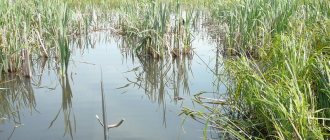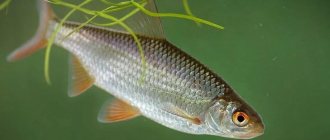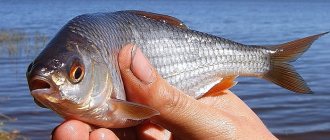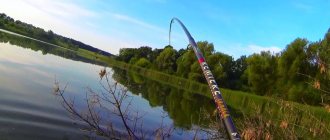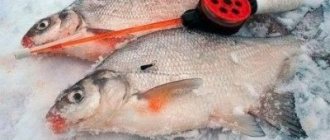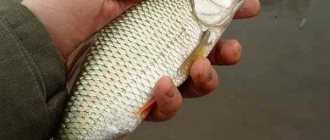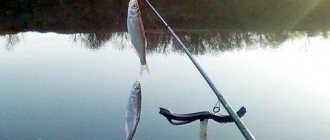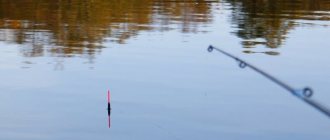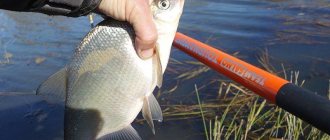It's no secret that every fisherman's dream is to catch a trophy fish, and when we go out for a fishing session, we hope to improve our results. But large fish such as carp, silver carp or grass carp are not found in all bodies of water and are caught during certain periods.
Therefore, it is not surprising that to quench our thirst for new fishing adventures, we go to rivers and lakes in the hope of catching other fish - bream, crucian carp, roach, and such fishing is no less interesting.
Of course, there will be those who will say that catching roach with a float rod is not trophy fishing and it does not arouse much interest, but true connoisseurs will confirm that this is not so.
What you need to know about roach
This fish is not as simple as it seems at first glance, and not every amateur angler achieves decent catches of roach. This is especially true for fishing with float rigs, which differ, for example, from donkeys in delicacy and even style.
In order to achieve a decent catch of roach you need:
- choose the right place on the shore of a reservoir;
- collect catching tackle;
- choose the right bait mixture and properly feed the fishing point;
- find an effective nozzle suitable for the conditions at hand.
If you simply choose a place convenient for the fisherman on the shore, attach a worm to the hook and throw the tackle into the water, this does not guarantee an outstanding catch. Therefore, it is important to understand where to look and how to catch this fish correctly, and then the fishing result will really please you.
At the same time, landing even a 200-300 gram roach on a float rig will bring a lot of positive emotions, which is what we expect from fishing.
It is not for nothing that roach is considered one of the most popular types of fish, because it is found in almost all inland waters of our country. This fish is found everywhere in lakes and rivers, and there is a lot of it in artificial reservoirs.
Not every fisherman knows that there are three subspecies of roach and these are:
- Siberian roach - chebak;
- vobla;
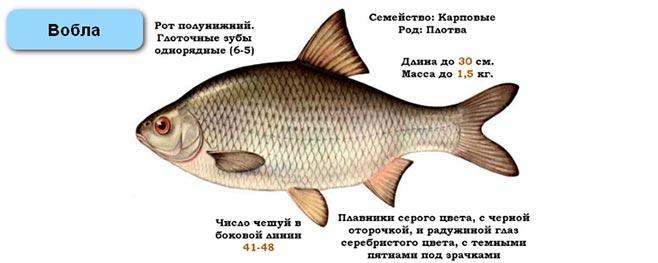
- ram.
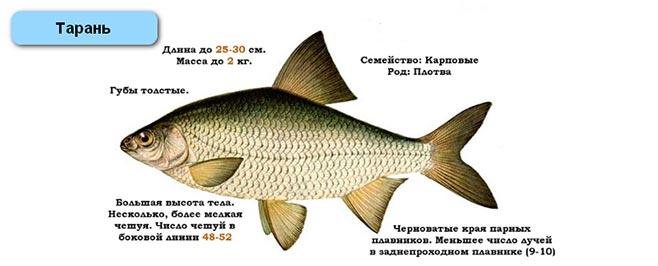
Roach is often confused with rudd, but these fish, of course, have differences. The rudd has orange eyes, and the roach has red eyes; in addition, the roach has a larger dorsal fin. In nature there are hybrids of these two fish, but an experienced fisherman will distinguish a real roach at first sight.
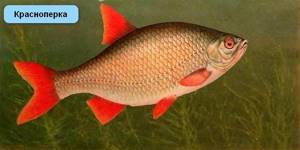
Chebak is the only representative of the roach family that is caught industrially. But ram and roach are caught with amateur or sports gear, both with feeders and floaters. Catching roach on a donk is not so interesting, but when using sensitive equipment, fishing is very exciting.
Roach is a schooling fish and moves around the reservoir in groups of several individuals of the same size. It’s rare to see a school of roach that contains both large specimens and fry, so if a heavy roach is hooked, the likelihood of catching several more trophies increases significantly.
Which bait to choose
Having dealt with the roach fishing rod and bait, you can move on to bait. Some fishermen believe that they can do without it. Of course, it is possible, but without treats it will be much more difficult, because there are fewer and fewer fish in the reservoir, and the existing fish should be of interest in something, so it is better not to skimp on this. In addition, knowing that something tasty is being poured into the same place, the roach will automatically swim there from time to time to profit from something. Therefore, if you want to leave with a catch, you should pay attention to this moment.
The most important thing is that you should prepare bait that the fish will appreciate. Typically, the delicacies consist of cake, corn, pearl barley, as well as various flavorings such as dill, anise oil, cumin, garlic, honey and others.
There are fishermen who prepare something at their own discretion, and then add various flavors to it. True, if you don’t want to invent anything and spoil the products, then it’s best to go to a specialized store and buy everything you need there. Of course, it will be a little more expensive, but it is quick and easy.

If you want to catch as many fish as possible, then it is possible to make sure that catching roach with a float rod is carried out using several rods. However, at the same time, you need to very carefully arrange your gear so that fishing does not result in a number of problems and troubles. It’s not uncommon for rods to overlap each other and then the fisherman tries for a long time to untangle what happened. Some people don’t pay attention to this, but in vain, because instead of ramming, some large and strong fish may begin to bite, which, if it does not steal the tackle, will force the fisherman to fight for it. By organizing the work correctly, you can be sure that the roach will bite more than once.
When and where to look for and catch roach
Fishing for roach continues throughout the year, but in winter the fish are inactive and it is much more difficult to catch them than in spring or autumn. Active roach biting begins when birch buds swell and continues until late autumn, while the water is not too cold.
The fish spawns after the water temperature reaches 8–10 degrees, and there is no migration in places where they usually stop. In warm water, roach moves to coastal areas and basks in the sun, becoming attractive prey for float anglers.
During such periods, the bite begins in the early morning and continues until the sun sets below the horizon, unless, of course, the angler regularly feeds the fishing point.
The fish bites are confident and the roach float instantly reacts to touching the nozzle. In summer, roach is caught using float gear not only from the shore, but also from a boat, and such fishing rewards with excellent catches.
With the onset of the first cold weather, the intensity of the bite decreases and by the end of autumn it is difficult to achieve a good catch; the fish go to their usual winter stops.
Features of catching rams at different times of the year

Spring
As soon as the water warms up to +7-10°C, the ram begins to spawn. Moreover, it does not spawn in the sea, but rises into rivers, bays and canals. The water in such places warms up much faster, and there is enough vegetation to feed and protect the fry. During the period when the ram spawns, any fishing, even amateur fishing, is prohibited. Therefore, you can start catching ram only at the beginning of summer, when after spawning it returns to its former habitats. It stops in coastal thickets of reeds or water lilies, where amateur fishermen catch it.
Summer
Hungry after spawning, the ram behaves very actively and bites on any bait, both animal and plant origin. And yet, the favorite baits are maggots and bloodworms, or combinations thereof.
Ram can be caught with any tackle, including a classic float rod. Recently, many anglers prefer a feeder.
By mid-summer, some of the fish go to sea, and some remain in the estuaries. What remains is called river ram. However, it does not go far from the border of fresh and salt water.
Sea rams are caught both from the shore and from a boat, using various tackles, including bottom ones. But sea ram is quite rare, so fishermen do not give preference to catching it. In the summer, like most fish, the ram switches to plant baits, but is unlikely to refuse maggots. During this period, she begins to be cautious and cannot take every bait.
Autumn
In the autumn, the ram again goes into rivers, estuaries and bays, where, gathered in flocks, it moves around the water area in search of food. Like all fish, ram during this period gains nutrients before wintering.
Winter
In winter, rams are also caught as in summer. To do this, you can use winter versions of fishing rods, including float ones.
Roach fishing gear
Float tackle is the most effective for catching roach, so anglers use it all year round, even in winter, using winter float rigs. The designs of installations may differ, but the main thing in them is the presence of a float, which acts as a bite alarm.
Rod
To catch roach, use float rods:
- plug;
- flight feathers;
- match;
- Bolognese.
Each type of fishing rod has both advantages and disadvantages, but the most popular are Bolognese blanks, which are convenient to transport and during fishing. But this does not mean at all that if a fisherman does not have a Bolognese rod, then he must purchase one for roach fishing.
Any float form will do, the main thing is that it is convenient for the fisherman when casting and retrieving. For example, when fishing at long distances, a match rod will be more convenient and effective.
A float rod for roach should be:
- light;
- durable;
- sensitive.
Even if the rod is mounted on stands after casting, its low weight is important for ensuring convenience when hooking and landing fish. But, given that roaches bite often and the tackle has to be re-casted constantly, anglers choose rods of the lightest weight in order to reduce physical stress.
Recreational fishing should be fun, and the characteristics of the rod, as well as its weight, are very important in this regard. High sensitivity of the rod is needed so that the most delicate bites are visible. When fishing with a heavy and rigid rod, weak bites are not visible and the fish eats the bait on the hook, and the angler does not even know about it.
Trophy roach weighing 200–300 grams or more confidently takes the bait and such a bite is still visible. But if a school of small rams or roaches comes up for bait, it is much more difficult to catch it due to the very gentle and unnoticeable touches of the fish on the bait.
When choosing a float rod, the conditions on the reservoir are taken into account, whether there is a current in it, and also what is the distance from the shore to the fishing point. Fishing with a float in a line forces the angler to hold the rod in his hands all the time, but on a still body of water after casting, the rod can be placed on stands.
fishing line
Roach is a small fish and to catch it, thin fishing lines that are hardly noticeable in the water are used. Braid is not used, and the diameter of the monofilament base of 0.14-0.16 mm is quite enough even for catching trophy specimens.
In the spring, when the water is especially clear, the camouflage properties of the fishing line play a big role and it is better to use colorless monofilament, which is almost invisible in the water. In summer, the water turns green and the fishing line is matched to its color, so in addition to transparent, a light green monofilament base is also suitable.
Leashes are also knitted from monofilament fishing line, but its diameter is less than 0.08-0.12 mm. A thin leash is less noticeable to the fish, and even if the hook gets caught on an underwater obstacle, only the leash will have to be torn off, and the tackle will remain intact and unharmed.
Hooks
Hooks are an important element of the float tackle, which determines whether the fish wants to take the bait. Large hooks are not placed on roaches so as not to scare away the potential trophy. The hook size is 14–18, or even 20 according to the European classification, and the main selection criterion is the baits used.
When fishing for roach with a float rod, it is desirable that the nozzle completely hides the hooks, and only the sting remains exposed. It is easier to attach bloodworms or maggots, which are a favorite treat for roach or ram, on a small hook. But even when fishing with plant baits, small hooks are more convenient, the main thing is that they are thin and sharp, and are good at cutting the fish’s soft lips.
The color of the hooks is not of fundamental importance, but it is better to have colored hooks in stock, sometimes the fish respond to them more actively than to dark ones. If, after the bite has subsided, no means to “stir up” it have helped, try placing colored hooks, this sometimes helps.
The Japanese company Gamakatsu produces excellent roach hooks, but Drennan, Preston or Owner also offer a large selection.
Important! Don't forget that a hook is a consumable item when fishing. At the first signs of dullness, replace it with a new one, this will prevent fish from disappearing and improve hooking.
Floats
The float is needed not only to signal the angler about a bite, but also to hold the hook with the nozzle at the desired depth.
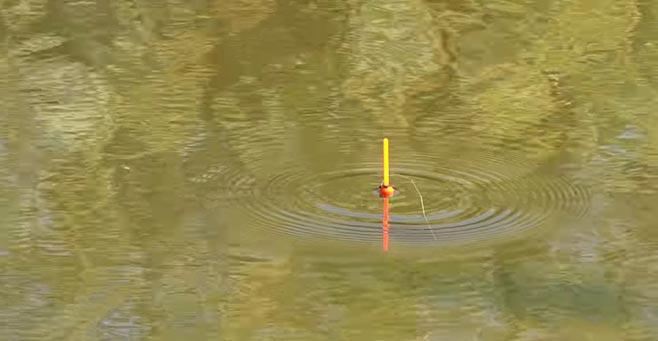
The float structure consists of:
- antennas;
- float bodies;
- keel;
- ring for attaching to fishing line.
Antenna
The antenna on the float is needed in order to ensure its good visibility both at short and long distances, regardless of the weather and general visibility. Floats with thin antennas are used for fishing with small baits:
- maggot;
- bloodworm;
- pearl barley and other grains.
Floats with thick antennas are used when fishing with large baits:
- corn;
- worm;
- dough.
Plug and match floats have long antennas. Floats with thick antennas are used when fishing for fish that feed in the water column and, in particular, when fishing for roach. If you intend to fish with anchored tackle, floats with a long antenna with a thickening in the middle are installed.
Float body
The float body is made of light and durable materials:
- polystyrene foam;
- plastics;
- wood.
It must be highly buoyant and resistant to moisture. Even after being in the water for a long time, the float must remain buoyant and perform its functions, helping the angler catch fish. The body of the float, streamlined in shape, is made in the form of a cylinder or ball.
The upper part of the float body, as well as the antenna, is painted in bright colors so that they can be seen from afar. The lower part of the body is painted with dark paint so that it is as invisible as possible from under the water.
Keel
The keel is necessary to stabilize the position of the float in the water after casting the tackle.
It is made from hard materials:
- plastic;
- metal
Floats with a long keel are used when fishing in the current, as well as in strong waves, wind or rain. But such a float takes longer to work and is not suitable for high-speed fishing of small fish.
They catch roach with floats with a short and weighted keel, which, after casting, quickly become vertical and are sensitive to any bite.
Ring on the keel
Floats are attached to the fishing line at one or more points. There are models in which the fishing line is passed through a hole in the float body, but for catching roach, those with a ring attached to the end of the keel are more convenient.
The float with the ring is fixed on the fishing line using float stoppers. Floats that do not have a ring on the keel are attached to the fishing line using a cambric.
Summer fishing
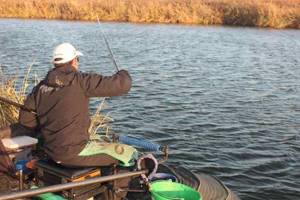
With the onset of summer, the roach begins to actively move to places with a large accumulation of vegetation, which in the summer is its main diet.
At this time of year, you need to look for it in creeks with water lilies or reeds, on shallows, on edges and near bridge supports. On small rivers, the sorog stands in snags or in the shade of trees in the coastal zone.
Preference is given to a hard bottom, but the most favorite places are the transition from hard (sand, clay) to silt. At the beginning of summer, roaches continue to be caught using animal baits (maggots, bloodworms, worms, caddis flies), with the rise of vegetation there is a transition to a different diet, and the baits change accordingly: • Dough; • Semolina mash; • White bread crumb; • Canned peas; • Canned corn; • Steamed pearl barley; • Wheat.
Bait in summer does not give a strong effect, but with its help you can still lure fish standing at a distance to the desired point. When using store-bought baits, you should not mix formulations from different manufacturers; the combination of their odors can scare away the prey.
Its color should be similar to the color of the bottom covering. Among the flavorings, hemp, anise, chocolate and coriander work well, but they should be added very carefully.
In June, you can add bloodworms and maggots, since the roach has not yet completely switched to a plant lifestyle. The main part should create an attractive dust cloud. The consistency should be such that the balls can be rolled, but when they hit the surface of the water they will disintegrate and create a column of fine food.
In June, the roach stands in places whose depth does not exceed 3-4 meters, so using a float rod is the most suitable option.
The groundbait used is the same as bait. When fishing on greens, they fish using the method of slow tracking along the bottom with periodic stops. Vegetation is obtained from the same reservoir, and caught at a depth of 1.5-2 meters.
In July, you can fish even at night, since the water is already quite warmed up; at this time, the roach is not at the bottom, but in the water column. At the beginning of August, preference is also given to plant bait, but by the middle the roach begins to switch to food of animal origin, which should also be added to the bait.

She is also already beginning to respond to various jigs (“nymph”, “pellet”, “goat”, “devil”, “uralka”). You can also catch it on a feeder, but in this case you need to use a fairly long leash (1-2 meters). Spring on a float
With the arrival of spring, reservoirs begin to open up and abundant oxygen saturation occurs. The fish begins to become very active at this time. To catch roach at this time of year, use the usual winter bait (dung or earthworm, maggot, bloodworm or burdock moth).
When the temperature rises to 10 degrees, the sorog begins spawning, after which it bites poorly for up to two weeks. During spawning, you can only catch roach from the shore and with one hook; this is regulated by law; the use of any watercraft is prohibited.
You need to fish in places where grass accumulates, in reed thickets and in quiet bays; the depth in such places usually does not exceed three meters. In such places there is an accumulation of insects and their larvae, which the roaches feed on, and at the same time there is a smooth transition to plant nutrition.
On rivers you need to look for places with steep banks or river bends, there are greater depths and there are always holes. The fact is that on rivers the sorog stands in the middle layers of water or lower, having not yet completely moved to summer feeding grounds.
In the spring, you need to feed the fish carefully enough so that it does not become satiated and move away. Usually a cast of 5 balls is made, maybe a little more, then one ball at a time every half hour.
If the bite is inactive or disappears completely, it is necessary to lengthen the leash or use thinner equipment. You can experiment with baiting the bait itself in different ways.
It is more difficult to catch any fish in closed reservoirs, as they are more careful and roach is no exception. A long leash is not needed, since the bait will lie on the bottom and will have to be set in motion independently, the maximum length is no more than half a meter, hooks of numbers 16 and 18 are used.
It’s not worth putting two leashes in the form of a rocker arm and expecting better fishing, such gear becomes coarser and you may simply not notice neat bites. Floats are used with a long, small keel, which increases the visibility of the bite.
Steamed pearl barley performs well during spring fishing; large roaches bite even on one grain; you can fish both in the depths and closer to the upper layers of the water.
There is no point in using flavorings; roaches readily respond to the natural smell of pearl barley. When baiting, the tip of the hook must be left open, so the grain will not fall off when casting.
Bread crumb with ground flour also works well, but you shouldn’t keep it in water for more than 10-15 minutes, as it will soften and fall off the hook.
When fishing for roach, both in spring and in other seasons, the composition should be such as to create a dust cloud, and not just fall to the bottom. Therefore, the main components in it should be ingredients that can create such an effect.
You can use molasses or liquid. You can buy them at the market or in a fishing store with various aromatic additives.
You can also add ground biscuits or breadcrumbs. When a flock approaches, usually no more than 10 bites occur, after which it disappears for a maximum of 15 minutes.
In this case, it is necessary to add additional portions of bait and the bite will definitely resume.
If the material was useful and now you know exactly how to catch roach in the summer using a float rod, then share your opinion in the comments.
Float tackle for roach
To install float gear on roach in still water you will need:
- float stops;
- leash with a hook 10–12 cm long;
- float with one attachment point on a swivel with a clasp;
- shot weights;
- swivel acting as a shepherd.
Installation of the float rod equipment on the roach is tied directly on the main fishing line:
- put a stopper on the fishing line and pull it up;
- put on the float swivel;
- put on another float stopper;
- We tie a swivel to the end of the fishing line with a Palomar knot;
- tie a leash to the swivel;
- At a distance of 20-30 cm from the lower swivel, we attach 3-4 pellets, acting as the main load.
While on the pond, the fisherman adjusts the depth of the float with the help of stoppers. It is necessary that only the float antenna remains on the surface of the water, then even gentle bites of small roach will be visible.
The distance between the swivel and the load should be greater than the length of the leash. If while fishing, due to inactive biting, the leash lengthens, this rule must be followed, otherwise the tackle will get tangled when casting. The weight of the load must correspond to the carrying capacity of the float and sink it to the antenna.
This rig is used with fly and plug rods, as well as with a Bolognese fishing rod, when fishing at close range. It won’t be possible to use it during currents because the weights or swivel will drag along the bottom and it will be difficult to see the bite.
Tackle float
If you are interested in catching roach in the fall with a float on the river, then you should choose sensitive models. Fishing conditions directly affect the choice of shape and size of the product. If there is no wind, then you need to buy a float whose weight is 0.4 grams. For fishing far from the shore, a weight of up to 1 gram is suitable. If you fish in the current, then use a float of 1 gram.
Floats for fishing in still water should be of a dim, but as natural shade as possible. These are white, blue, green accessories. These options are especially suitable if you fish only on the src=»https://plotva.by/image/data/novosti/lov-plot-yf-popl/popl4.jpg» class=»aligncenter» width =”860″ height=”405″[/img]
Almost any fishing rod will do:
- Choose a very thin fishing line, as only in this case the fishing will be effective.
- Choose a hook that is not too large but sharp.
- Be careful when choosing a float.
Float tackle for long casting
When fishing at a long distance with a match rod, a rig with a sliding float is mounted. When you catch roach close to the shore, it is much easier to correctly set the diving depth so that the tackle is as sensitive as possible.
For this purpose, float stops are used, lowered or raised along the fishing line to the desired point. Only the float antenna should be visible in the water, then even the most careful fish bites will be clearly visible. At long distances it is difficult to accurately position the float and therefore a tackle with a sliding float and an olive-type weight is used.
To tie such a tackle you will need:
- leash with hook;
- olive weight;
- float stops;
- sliding float with ring;
- rubber mounting bead;
- swivel number 8-10.
The installation is knitted directly on the pond, on the main fishing line:
- thread the float stopper onto the main line and pull it to the desired height;
- put a float on the fishing line;
- stretch another stopper onto the fishing line;
- place a weight on the olive;
- string a bead;
- tie a swivel to the end of the fishing line;
- Attach a leash with a hook to the swivel.
The mounting bead is needed so that the olive weight does not “break” the knot that attaches the swivel to the leash. At the beginning of fishing, the approximate depth at the fishing point is set. If the float floats up to half the “body”, then the hook lies on the bottom; if it lies on the water, the hook and sinkers lie on the bottom, in this case the upper stopper should be lowered.
The lower stopper should be at a distance of 10–15 cm from the swivel so that the weight slides along the line, limited by the stopper and the bead. There is no need to make the distance between the swivel and the stopper too large, otherwise it will be inconvenient to throw the tackle.
Having reeled in the fishing line and left an overhang of 40–50 cm, the fisherman casts the equipment to the fishing point. In this case, the weight and float slide down to the swivel, without interfering with an accurate cast. The depth at the fishing point can be large, and the upper stopper will have to be raised high along the line. In this case, the stopper should slide freely into the rings of the match rod, that is, they should be quite large.
If you take a very small float stopper, it can slip into the float ring when casting and the tackle will not take the working position. In this case, use pliers to tighten the ring on the float so that the stopper does not slip through. For long-distance fishing, floats with a carrying capacity of 7–10 grams with high antennas and a weighted keel are used. They are clearly visible in any weather, and they are much easier to cast.
The installation is done in such a way that the hook and nozzle lie on the bottom, unless, of course, the weight of the olive matches the weight of the float. If you take a smaller weight and lower the upper stopper to the required distance, the hook will float in the water column. In this way, the depth of immersion is regulated, and roach is caught both in the water column and from the surface.
Roach baits

Roach is an almost omnivorous fish, but at different times of the year it is caught with different baits.
In spring and autumn, animal feed is more effective and this fish is caught on:
- maggot;
- bloodworm;
- dung worm;
- river worm;
- caddisfly;
- burdock.
The rig is equipped with small hooks for 2-3 maggot or bloodworm larvae, and the ram or roach bites on them with great pleasure.
Interesting! at the end of spring, the larva of the Colorado potato beetle becomes the “secret” bait for the roach. Few fishermen have seen this attachment in action and there is absolutely no reason to use it on their fishing trips. The bright red larva is attractive to fish and stays well on the hook, even after several casts.
Warming water affects the gastronomic preferences of roaches and in summer they bite better on:
- barley;
- wheat;
- dough;
- bread balls;
- hominy.
In the process of catching trophy roach from the bottom, small foam balls are used as bait, raising the hook and balancing its mass. Despite the fact that such a bait does not have any nutritional value for the fish, its curiosity affects it and bites follow one after another.
Important! Bread crumb mashed with the yolk of a chicken egg and a small amount of finely ground roasted seeds is an excellent recipe for roach dough in the summer. It is prepared quickly, right on the pond and shows good results.
Lure
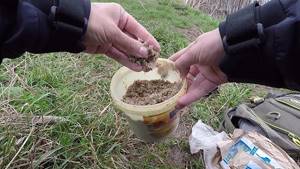
Having arrived at a reservoir for roach fishing, and having chosen a good place, first of all you should mix the bait mixture and let it brew to the desired condition.
Experienced fishermen make bait even before collecting the tackle, because the bait mixture has to be moistened several times and there is plenty of time for other purposes.
The roach needs to be fed frequently, so a lot of bait is prepared, on average 2–3 kilograms per day session. Only in early spring and late autumn can you overfeed the fish, and in the summer, frequent feeding of the fish can only be beneficial.

Fishing stores sell special bait for roach marked Roach, and if you don’t want to experiment and make bait yourself, it’s better to buy 3–4 kg of such a mixture and be fully prepared. Finely ground roach bait with a pronounced aroma that attracts schools of fish.
It is mixed with water from a reservoir ( not from the tap! ) to the consistency of crushed plasticine and rolled into balls. The fisherman prepares 30-40 balls of bait the size of a fist in advance and throws it at the fishing point every 5-10 minutes. This is the only way to keep the fish at the point and catch them in sufficient quantities.
Casting bait is done by hand, or with the help of a special slingshot, which you make yourself or buy in a store. The density of the balls should be such that they do not scatter in flight, but fall apart when they hit the water, creating a column of attractive-smelling turbidity.
It is impossible to feed a voracious roach with properly prepared bait, but you will definitely be able to attract its attention to the bait on the hook. To weight the balls, clay or soil from a reservoir is used, which is mixed with bait during the moistening stage.
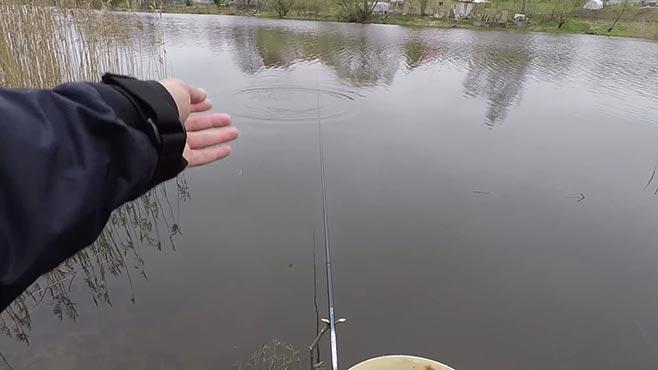
There is no need to be afraid of noise when casting balls of bait; it will not scare away the roaches, and sometimes even on the contrary, it serves as an additional attracting factor.
To increase the nutritional value of bait for roaches, especially in early spring, chopped worms and food bloodworms are added to it, but in small quantities.
What bait should I use?
If we talk about bait, it is simply impossible to do without it. Usually people fish in one place without changing location, so the fish need to be lured correctly. She will return to the place you have planned, so you are guaranteed to return home with a catch.
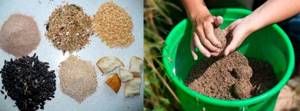
The bait must contain natural ingredients. It can be corn, cake, wheat. Do not ignore natural flavors. For example, take cumin or garlic.
To make fishing more effective, you can use several fishing rods. The fishing place must be organized according to all the rules. Make sure that the fishing rods do not overlap each other, as otherwise you may miss a large trophy.

